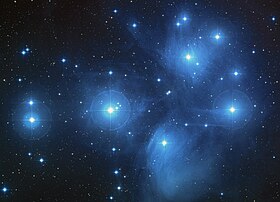
Back ألسيوني (نجم) Arabic Alcíone (estrella) AST Алкиона (звезда) Bulgarian Alcíone (estrella) Catalan Alcyone Czech Alkione (Stern) German Αλκυόνη (αστέρας) Greek Alcíone (estrella) Spanish نیرثریا Persian Alcyone (tähti) Finnish
| Observation data Epoch J2000 Equinox J2000 | |
|---|---|
| Constellation | Taurus |
| Right ascension | 03h 47m 29.077s[1] |
| Declination | 24° 06′ 18.49″[1] |
| Apparent magnitude (V) | 2.87[2] |
| Characteristics | |
| Spectral type | B5IIIe[3] |
| U−B color index | −0.34[2] |
| B−V color index | −0.09[2] |
| Astrometry | |
| Radial velocity (Rv) | 5.40[4] km/s |
| Proper motion (μ) | RA: 19.34±0.39[1] mas/yr Dec.: −43.67±0.33[1] mas/yr |
| Parallax (π) | 8.09 ± 0.42 mas[1] |
| Distance | 136[5] pc |
| Absolute magnitude (MV) | −2.62[6] |
| Details | |
| Mass | 5.9 – 6.1[7] M☉ |
| Radius | 9.3±0.7[8] R☉ |
| Luminosity | 2,030[9] L☉ |
| Surface gravity (log g) | 3.047[3] cgs |
| Temperature | 12,258[3] K |
| Rotational velocity (v sin i) | 149[3] km/s |
| Age | 70[10] Myr |
| Other designations | |
| Database references | |
| SIMBAD | data |
Alcyone /ælˈsaɪəniː/,[11] designated η Tauri (Eta Tauri, abbreviated Eta Tau, η Tau), is a star in the constellation of Taurus. Approximately 440 light-years from the Sun, it is the brightest star in the Pleiades open cluster, which is a young cluster, around 100 million years old. There are a number of fainter stars very close to Alcyone, some of which are members of the same cluster.[citation needed]
- ^ a b c d e Cite error: The named reference
van Leeuwen2007was invoked but never defined (see the help page). - ^ a b c Ducati, J. R. (2002). "VizieR Online Data Catalog: Catalogue of Stellar Photometry in Johnson's 11-color system". CDS/ADC Collection of Electronic Catalogues. 2237. Bibcode:2002yCat.2237....0D.
- ^ a b c d Touhami, Y.; Gies, D. R.; Schaefer, G. H.; McAlister, H. A.; Ridgway, S. T.; Richardson, N. D.; Matson, R.; Grundstrom, E. D.; Ten Brummelaar, T. A.; Goldfinger, P. J.; Sturmann, L.; Sturmann, J.; Turner, N. H.; Farrington, C. (2013). "A CHARA Array Survey of Circumstellar Disks around Nearby Be-type Stars". The Astrophysical Journal. 768 (2): 128. arXiv:1302.6135. Bibcode:2013ApJ...768..128T. doi:10.1088/0004-637X/768/2/128. S2CID 9488327.
- ^ Gontcharov, G. A. (2006). "Pulkovo Compilation of Radial Velocities for 35 495 Hipparcos stars in a common system". Astronomy Letters. 32 (11): 759–771. arXiv:1606.08053. Bibcode:2006AstL...32..759G. doi:10.1134/S1063773706110065. S2CID 119231169.
- ^ Melis, Carl; Reid, Mark J.; Mioduszewski, Amy J.; Stauffer, John R.; et al. (29 August 2014). "A VLBI resolution of the Pleiades distance controversy". Science. 345 (6200): 1029–1032. arXiv:1408.6544. Bibcode:2014Sci...345.1029M. doi:10.1126/science.1256101. PMID 25170147. S2CID 34750246.
- ^ Zhang, P.; Liu, C. Q.; Chen, P. S. (2006). "Absolute Magnitudes of Be Stars Based on Hipparcos Parallaxes". Astrophysics and Space Science. 306 (3): 113. Bibcode:2006Ap&SS.306..113Z. doi:10.1007/s10509-006-9173-1. S2CID 122897957.
- ^ Zorec, J.; Frémat, Y.; Cidale, L. (2005). "On the evolutionary status of Be stars. I. Field Be stars near the Sun". Astronomy and Astrophysics. 441 (1): 235–248. arXiv:astro-ph/0509119. Bibcode:2005A&A...441..235Z. doi:10.1051/0004-6361:20053051. S2CID 17592657.
- ^ Cite error: The named reference
White2017was invoked but never defined (see the help page). - ^ Harmanec, P. (2000). "Physical Properties and Evolutionary Stage of Be Stars". The be Phenomenon in Early-Type Stars. 214: 13. Bibcode:2000ASPC..214...13H.
- ^ Cite error: The named reference
brandt2015was invoked but never defined (see the help page). - ^ "Alcyone". Merriam-Webster.com Dictionary.
© MMXXIII Rich X Search. We shall prevail. All rights reserved. Rich X Search
